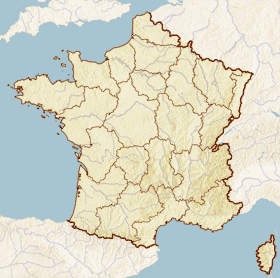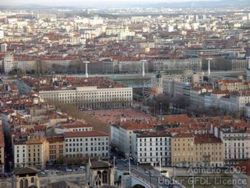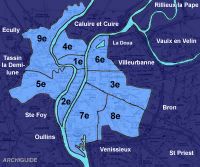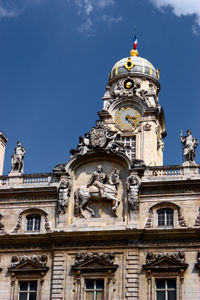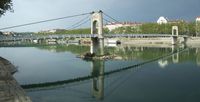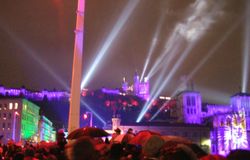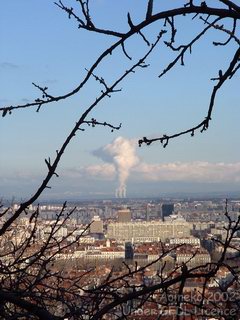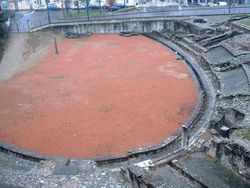Lyon
2007 Schools Wikipedia Selection. Related subjects: European Geography
| Ville de Lyon | ||
|
 |
|
| City flag | City coat of arms | |
| Motto: Avant, avant, Lion le melhor. ( Arpitan: Forward, forward, Lyon the best) |
||
| Location | ||
|
||
| Coordinates | ||
| Time Zone | CET (GMT +1) | |
| Administration | ||
|---|---|---|
| Country | France | |
| Région | Rhône-Alpes | |
| Département | Rhône (69) | |
| Subdivisions | 9 arrondissements | |
| Intercommunality | Urban Community of Lyon |
|
| Mayor | Gérard Collomb ( PS) (since 2001) |
|
| City Statistics | ||
| Land area¹ | 47.87 km² | |
| Population² | 3rd in France | |
| - 2004 estimate | 465,300 | |
| - Density | 9,720/km² (2004) | |
| Urban Spread | ||
| Urban Area | 954 km² (1999) | |
| - Population | 1,348,832 (1999) | |
| Metro Area | 3,306 km² (1999) | |
| - Population | 1,648,216 (1999) | |
| ¹ French Land Register data, which excludes lakes, ponds, glaciers > 1 km² (0.386 sq. mi. or 247 acres) and river estuaries. | ||
| ² Population sans doubles comptes: single count of residents of multiple communes (e.g. students and military personnel). | ||
Lyon (traditionally Lyons in English and Liyon in Arpitan; pronounced /ljɔ̃/ in French) is a city in east central France. The third largest French city, it is a major centre of business, situated between Paris and Marseille, and has a reputation as the French capital of gastronomy and a significant role in the history of cinema.
Together with its suburbs and satellite towns, Lyon forms the second largest metropolitan area in France after Paris, with 1,648,216 inhabitants at the 1999 census, and approximately the 20th to 25th largest metropolitan area of Western Europe.
Lyon is the préfecture (capital) of the Rhône département, and also the capital of the Rhône-Alpes région.
The city gave its name to the Lyonnais province, of which it was the capital. Today the region around Lyon is still known as Lyonnais (French: le Lyonnais), or sometimes even as the Lyonnaise Region (French: Région Lyonnaise). Lyonnaise Region is an unofficial, popular name, not to be confused with the administrative région of Rhône-Alpes, which is much larger than the Lyonnaise Region.
Lyon is also the international headquarters of Interpol.
Geography
Lyon's geography is dominated by the Rhône and Saône rivers which converge to the south of the historic city centre forming a sort of peninsula or "presqu'île"; two large hills, one to the west and one to the north of the historic city centre; and a large plain which sprawls westward from the historic city centre.
To the west is Fourvière, known as "the hill that prays", the location for the highly decorated Notre-Dame de Fourvière basilica, several convents, the palace of the Archbishop, the Tour métallique (a highly visible TV tower, replicating the last stage of the Eiffel Tower) and a funicular.
To the north is the Croix-Rousse, "the hill that works", traditionally home to many small silk workshops, an industry for which the city was renowned.
The original medieval city ( Vieux Lyon) was built on the west bank of the Saône river at the foot of the Fourvière hill, west of the presqu'île. (This area, along with portions of the presqu'ile and much of the Croix-Rousse are recognized as a UNESCO World Heritage Site, see below.)
On the peninsula (presqu'ile) between the rivers Rhône and Saône, is the third largest public square in France, and one of the largest in Europe, the Place Bellecour. Specifically, it is the largest clear square (i.e., without any patches of greenery, trees or any other kind of obstacles) in Europe : "the largest pedestrian square in Europe". The broad, pedestrian-only Rue de la République leads north from Place Bellecour.
East of the Rhône from the presqu'ile is a large area of flat ground upon which sits much of modern Lyon and most of the city's population.
Situated in this area is the urban centre of Part-Dieu which clusters the former Credit Lyonnais Tower (central France's only skyscraper), the Part-Dieu shopping centre, and Lyon's main rail terminal, Lyon Part-Dieu.
North of this district is the relatively wealthy sixth arrondissement which is home to the Parc de la Tête d'Or, one of Europe's largest urban parks, and Interpol's headquarters.
Administration
Lyon is the capital of the Rhône-Alpes région, the préfecture of the Rhône département, and the capital of 14 cantons, covering 1 commune, and with a total population of 445,452 (1999).
Arrondissements
Lyon, similarly to Marseille and Paris is divided into 9 municipal arrondissements (often translated into English as borough), referred to by number. The arrondissements were originally created in 1852 when a number of surrounding communes ( Croix-Rousse, Guillotière, and Vaise) were annexed to Lyon. In 1963 Lyon annexed the commune of Saint-Rambert-l'Île-Barbe, and in 1964 the 9th arrondissement of Lyon was created as a result of the annexation, thus reaching a total of nine arrondissements, which are still the arrondissements found in Lyon today. Within each arrondissement, there are a number of recognisable "quartiers" or neighborhoods:
- 1st arrondissement: Pentes de la Croix-Rousse, Les Terreaux, Saint-Vincent
- 2nd arrondissement: Cordeliers, Bellecour, Ainay, Perrache et Confluent
- 3rd arrondissement: La Part-Dieu, La Villette, Montchat, La Guillotière, Sans-souci
- 4th arrondissement: La Croix-Rousse, Serin
- 5th arrondissement: Saint-Jean- Saint-Paul - Saint-Georges (Vieux Lyon), Saint-Just, Fourvière, Le Point-du-Jour, Ménival, Champvert, La Sarra, Saint-Irénée
- 6th arrondissement: Les Brotteaux, Bellecombe, Tête d'Or
- 7th arrondissement: La Guillotière, Gerland, La Mouche
- 8th arrondissement: Monplaisir, Le Bachut, Mermoz, États-Unis, Le Grand Trou, Moulin à Vent, Laënnec, Grange-Blanche
- 9th arrondissement: Vaise, La Duchère, Saint-Rambert-l'Île-Barbe
History
Lyon was founded as a Roman colony in 43 BCE by Munatius Plancus, a lieutenant of Caesar, on the site of a Gaulish hill-fort settlement called Lug[o]dunon—from the Celtic sun god Lugus ('Light', cognate to Old Irish Lugh, Modern Irish Lú) and dúnon (hill-fort). The name was latinised as Lugdunum; Lug was equated by the Romans to Mercurius. Lug's ' totem' was a cockerel (rooster), hence the Modern French association with 'le coq'.
The three parts of Gaul mentioned by Caesar met at Lyon. Agrippa recognized that Lugdunum's position on the natural highway from northern to south-eastern France made it a natural communications hub, and he made Lyon the starting point of the principal Roman roads throughout Gaul. It then became the capital of Gaul, partly thanks to its fortunate site at the convergence of two navigable rivers, and quickly became the main city of Gaul. Two emperors were born in this city: Claudius and Caracalla. In our days, the archbishop of Lyon is still referred to as " le primat des Gaules".
The Christians in Lyon were persecuted for their religious views under the reigns of the Roman emperors Marcus Aurelius and Septimus Severus. These included saints such as Blandina (Blandine), Pothinus, and Epipodius, among others.
The great Christian bishop of Lyon in the 2nd century was the Easterner Irenaeus.
Burgundian refugees from the destruction of Worms by Huns in 437 were resettled by the military commander of the west, Aëtius, at Lugdunum, which was formally the capital of the new Burgundian kingdom by 461.
In 843, by the Treaty of Verdun, Lyon, with the country beyond the Saône, went to Lothair I.
Fernand Braudel remarked, "Historians of Lyon are not sufficiently aware of the bi-polarity between Paris and Lyon, which is a constant structure in French development" from the late Middle Ages to the Industrial Revolution (Braudel 1984 p. 327). The fairs in Lyon, the invention of Italian merchants, made it the economic countinghouse of France in the late 15th century. When international banking moved to Genoa, then Amsterdam, Lyon simply became the banking centre of France; its new Bourse (treasury), built in 1749, still resembled a public bazaar where accounts were settled in the open air. During the Renaissance, the city developed with the silk trade, especially with Italy; the Italian influence on Lyon's architecture can still be seen. Thanks to the silk trade, Lyon became an important industrial town during the 19th century.
Lyon was a scene of mass violence against Huguenots in the St. Bartholomew's Day Massacres in 1572.
The silk workers of Lyon, known as canuts, staged two major uprisings: in 1831 and 1834. The 1831 uprising saw one of the first recorded uses of the black flag as an emblem of protest.
Lyon was a centre for the occupying German forces and also a stronghold of resistance during World War II, and the town is now home to a resistance museum. (See also Klaus Barbie.) The traboules, or secret passages, through the houses enabled the local people to escape Gestapo raids.
Culture
As early as the 13th century, the Arpitans, residents of the region spoke a dialect of the Arpitan (often called the Franco-Provençal language too). This Lyonnais dialect was replaced by the French language as the importance of the city grew. Lyon was an early centre for printing books, and nurtured a circle of 16th century poets. For several centuries Lyon and its bouchons have been known as the capital of gastronomy, fine handweaving, and the silk trade. The Lumière brothers invented cinema in the town in 1895. December 8 each year is marked by "la Fête des lumières" (the Festival of Lights), a celebration of thanks to the Virgin Mary, who purportedly saved the city from a deadly plague in the Middle Ages. During the event, the local population places candles in their windows and the city of Lyon organizes and projects impressive large-scale light shows onto the sides of important Lyonnais monuments, such as the mediaeval Cathédral St-Jean.
Two of France's best known wine-growing regions are located near Lyon: the Beaujolais to the North, and the Côtes du Rhône to the South.
Lyon also features a renowned opera house.
UNESCO World Heritage Site
The Saint-Jean and the Croix-Rousse areas, which are noted for their narrow passageways ( traboules) that pass through buildings and link the streets either side, were designated UNESCO World Heritage Sites in 1998.
Colleges and universities
- CPE Lyon
- École Centrale de Lyon
- ECAM Lyon (École Catholique d'Arts et Métiers de Lyon) http://fr.wikipedia.org/wiki/ECAM http://www.ecam.fr
- EM Lyon (École de Management de Lyon)
- École Normale Supérieure de Lyon
- École Normale Supérieure Lettres et Sciences Humaines
- École Nationale des beaux-arts de Lyon
- Institut National des Sciences Appliquées de Lyon
- Institut d'études politiques de Lyon
- Institution des Chartreux http://www.leschartreux.com
- Université Claude Bernard (Lyon I)
- Université Louis Lumière (Lyon II)
- Université Jean Moulin (Lyon III)
- Université Catholique de Lyon
- Université professionelle internationale de Lyon (UPIL)
- ESDES Business School
- École Nationale des Travaux Publics de l'État
- La Martiniere Lyon
Main sights
- Tour métallique de Fourvière ( 1894)
- La Mouche Cattle Market and Abbatoir ( 1914, 1928), designed by Tony Garnier.
- Sainte Marie de La Tourette monastery ( 1960) designed by Le Corbusier
- Saint-Exupéry International Airport (formerly Satolas Airport, 1975), designed by Guillaume Gilbert.
- Opéra National de Lyon, renovated in 1993 by Jean Nouvel.
- Lyon Airport Railway Station ( 1994) by Santiago Calatrava.
- Cité Internationale ( 1998), designed by Renzo Piano.
- Cathédrale Saint-Jean
- Basilica of Notre-Dame de Fourvière.
- Basilica of St-Martin-d'Ainay.
- The church of Ainay, dating from the tenth and eleventh centuries, is of the Byzantine style.
- The doorway of St. Nizier's (fifteenth century) was carved in the sixteenth century by Philibert Delorme.
Transport
Air
Saint-Exupéry International Airport is located 20 km to the east of Lyon, and serves as a base for regional and low-cost flights, including EasyJet. Long haul flights generally depart from Paris's Charles de Gaulle Airport.
Rail
Lyon is connected to the North (Lille, Paris) and the South (Marseille, Montpellier) by the TGV. It was the first city to be connected by the TGV c. 1982.
Lyon has two major train stations: Lyon-Part-Dieu, which was built to accommodate the TGV and has become the principal train station for extra-regional trains; whereas Lyon-Perrache is an older station that now primarily serves regional rail transport. In practice, many trains, including TGVs, serve both stations. Smaller train stations include Gorge de Loup, Vaise and Venissieux.
Road
The City is at the heart of a dense road network and is the joing point of several motorways: A7 but also the A43, A40 and routes ationales RN7 and RN6. The city is now bypassed by the A48.
Intercity coach
Lyon is served by the Eurolines intercity coach organisation. Its Lyon terminal is located at the Lyon-Perrache train station.
Public transport
The TCL (French:Transports en Commun Lyonnais), Lyon's public transport, consisting of metros, buses and trams, serves 62 communes of the Lyon agglomeration. The metro system has 4 lines, including one fully-autonomous one, 38 stations and runs with a frequency of up to a metro every 2.5 minutes. The bus system consists of normal buses, trolley buses powered by overhead lines, and coaches for areas outside the centre, but which operate on the same ticketing scheme. There are two tram lines, running from Montrochet in the south to IUT-Fessine in the north, and from Perrache station in the southwest to Saint-Priest in the southeast.
Lastly, Vélo'v is a bicycle network providing a low cost and convenient bicycle hire service where bicycles can be hired at dropped of at any of several hundred stations throughout the city. However, the bicycle rent stations are only in french which might cause some trouble for non-french speaking travelers.

